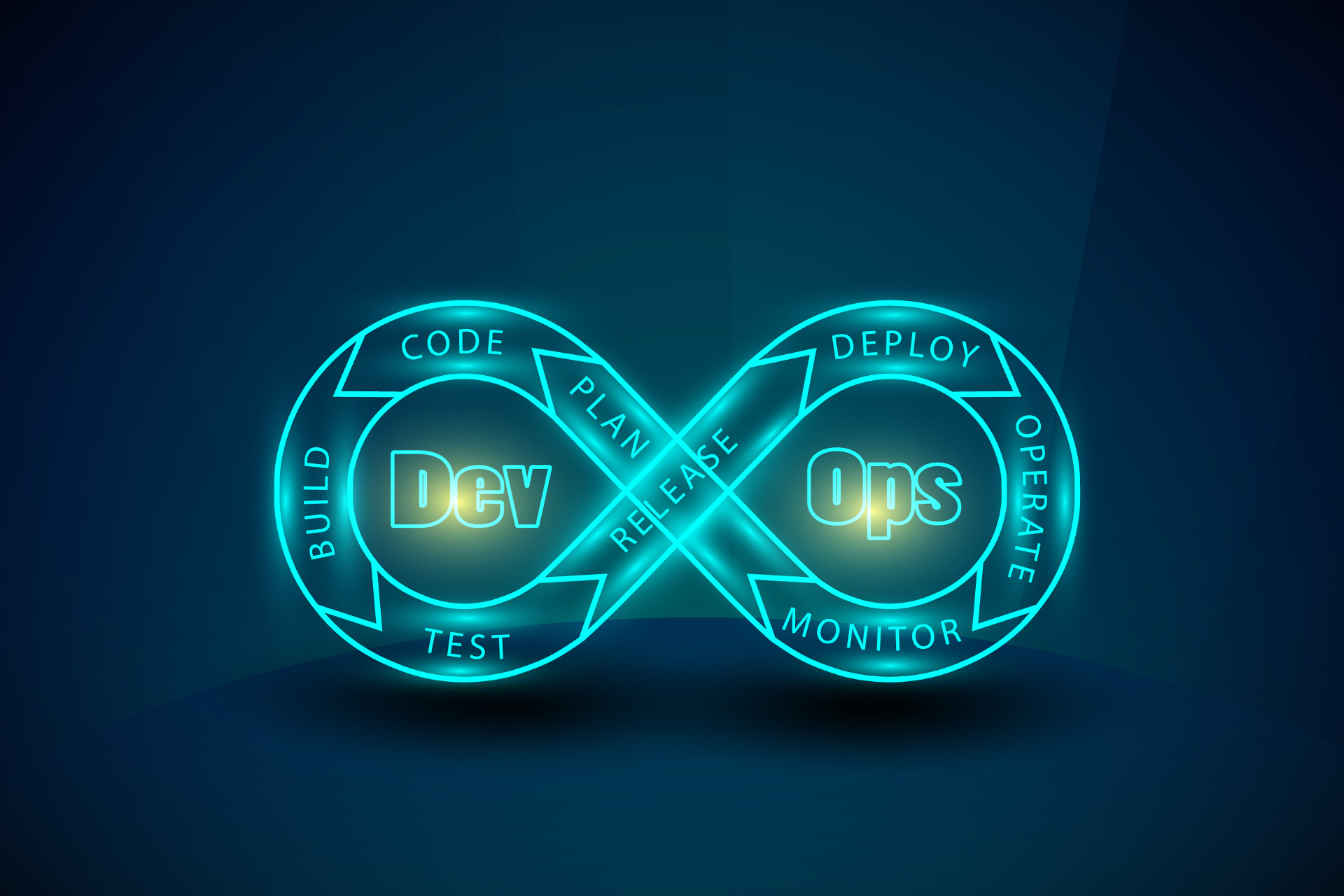DevOps can be divided into two types of subject.
It’s a philosophy or culture that’s constantly evolving, rather like the agile culture, and it’s also a framework (software infrastructure) designed to energize and improve application development, to speed up the delivery of new features, software updates or products.
It fosters continuous communication, collaboration, integration, visibility and transparency between application development (Dev) and IT operations (Ops) teams.
This closer relationship between Dev and Ops is reflected in every phase of the DevOps lifecycle: software planning, coding, development, testing, release, deployment, monitoring operations, all on a continuous basis.
It constantly generates customer feedback, which reinforces the potential for improvement during development, testing and deployment. One example is the accelerated and permanent publication of changes or additions to functionality.
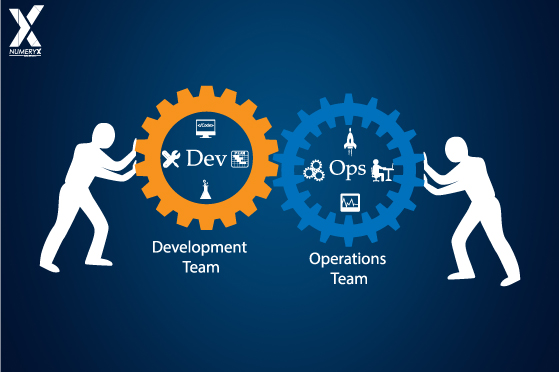
DevOps objectives fall into four categories:
- culture,
- automation,
- Time To Market
- customer satisfaction.
In each of these areas, DevOps tools improve the streamlining and collaboration of Development AND Operations workflows (or pipelines).
By automating time-consuming, manual tasks, such as obtaining statics, tasks in the various integration phases, tasks linked to development, testing, deployment and monitoring, the DevOps approach saves a considerable amount of time.
The DevOps approach
DevOps practices continuously improve processes, while automating them. Many of them focus on one or more phases of the development cycle:
Development :
By covering the planning and coding phases in the DevOps lifecycle
Continuous testing :
By providing automated, planned and continuous testing when writing or updating application code, which speeds up code delivery to production.
Continuous integration :
By bringing together configuration management, testing and development tools to track the release of different portions of the code. Continuous integration involves close collaboration between the teams responsible for testing and development, to quickly identify and resolve code problems.
Delivery continues:
By automating the publication of code changes after the test phase, in an intermediate or pre-production environment.
Continuous deployment :
Unlike continuous delivery, continuous deployment involves automating the release of new or modified code into the production environment. Companies may need to publish changes to code or functionality several times a day.
Continuous monitoring.
This practice involves continuous monitoring of the code being executed and the underlying infrastructure. Developers receive feedback on bugs or problems.

What are the benefits of DevOps?
There are three major advantages to DevOps:
Direct collaboration between Dev and Ops
DevOps fosters an environment where different teams work together towards common goals. It facilitates collaboration by breaking down the barriers between different teams, encouraging them to work together towards a common goal: creating more value for the company. The motivations that lead Dev and Ops to join forces are, on the one hand, to pool their thoughts in the very early phases of work (upstream), and on the other, to improve the operational workflow of a product.
Better collaboration between teams
This naturally entails additional training from Ops to Dev, and from Dev to Ops, so that they can best coordinate their efforts across the entire project, and acquire a similar level of knowledge and technical mastery.
In the long term, the idea is not to have two halves of the team, each with its own specialization, but to have a single team with dual DevOps specialization.
Increased automation of the entire DevOps chain
By pooling Dev & Ops work, the team is able to automate the entire chain.
Faster problem resolution and reduced problem complexity
With permanent monitoring and an automated alert system, Dev & Ops can quickly get to grips with an incident and work on resolving it almost immediately.
Better visibility of system results
Continuous monitoring allows you to record the results of the system as it is being developed.
Improving customer experience and satisfaction
With more frequent releases, rapid availability of multiple software versions and features, and frequent product updates, while ensuring quality and sometimes security, DevOps ticks all the boxes for customer satisfaction.
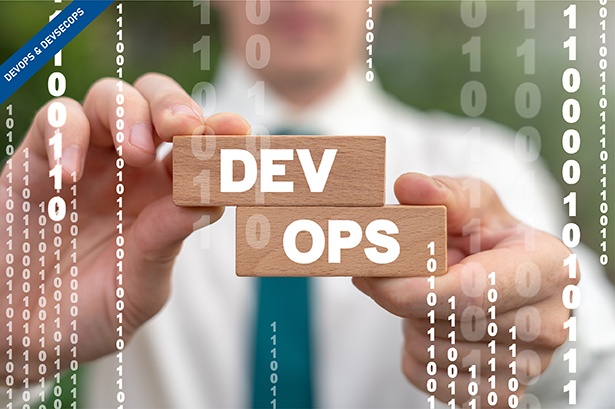
DevOps brings a rapid pace of delivery, with just one team.
There are fewer revisions to be made, no more back-and-forth between two teams, no more blaming one side or the other, a complete consideration of the project and the issues to be addressed… With increased velocity, companies therefore have the opportunity to develop new sources of revenue more quickly, particularly on customers’ current projects!
By reducing response and processing times, companies will be able to put their staff to work on higher value-added activities, which will also apply to the customer’s project.
DevOps brings greater stability to :
The DevOps automation approach makes it easier to deal with man-made incidents by reducing manual operations through automated release processes.
De facto, this makes results more predictable upstream of production releases.
Automation coupled with continuous testing means that software can be delivered faster, more efficiently, more reliably and with real-time quality of service.
This represents a significant competitive advantage over an organization with two teams instead of one.
Since DevOps offers a differentiated, optimized customer experience, it gives the project a unique character.
This “tailor-made” dimension, which can be adjusted with agility, not only wins over customers, but also builds loyalty and wins over new ones.
Customers like this DevOps method, and it’s a differentiating factor, and a major asset in the early sales phases.
Shorter time-to-market
One of the benefits of DevOps is that it accelerates the frequency and speed with which companies can bring new products to market, and thus maintain a competitive edge.
This reduction in the time between the idea that emerges to create a new product and its availability on the market, has become a strategic objective for many new technology-oriented companies.
It goes without saying that the faster a company can offer new products, the faster it can produce updates and patches.
By causality, the more it improves its products, the more the company will benefit from the commercial value of its products’ functionalities.
Time savings on production start-up mean faster deliveries
With DevOps, companies streamline processes and improve Dev and Ops efficiency.
In this way, companies can spend more time on product and service innovation, while reducing their development and operational costs.
DevOps therefore gives a company the ability to keep up with the market more quickly and with less difficulty.
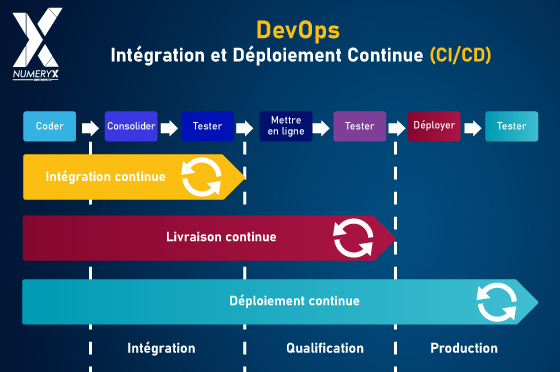
What is the CI/CD process?
Increased automation of the entire DevOps chain is based, among other things, on the combination of Continuous Integration and Continuous Delivery, also known as the CI/CD pipeline.
CI/CD stands for Continuous Integration/Continuous Delivery.
The French equivalent is “Intégration Continue / Livraison Continue”.
CI/CD is a fundamental DevOps process, commonly referred to as the CI/CD pipeline.
This CI/CD process therefore brings together two complementary sets of practices, most of which are based on automation.
The Continuous Integration (CI) process
Developers integrate new code into the main source code on a daily basis.
This new code is stored in a central, shared repository, and an automated process then automatically and continuously tests and validates the changes.
The aim is to enable developers to quickly identify potential problems after each code addition, and to receive immediate alerts so they can make the necessary corrections to ensure the software runs smoothly.
Continuous Integration automates the process of creating, packaging and testing code every time a team member validates code changes in version control or management.
With this pipeline, teams can easily modify and control code, which improves collaboration and application quality.
The Continuous Delivery (CD) process
First of all, don’t confuse “Continuous Deployment” with “Continuous Delivery”, which are both acronyms for “CD” in development circles, and in the DevOps chain.
Continuous Delivery, the second part of the CI/CD pipeline, is an extension of Continuous Integration, since it automatically deploys all code modifications in a test and/or production environment after the build stage.
This means that in addition to automated testing, you also have an automated publishing process.
The CI/CD pipeline in a nutshell
The main concepts involved in the CI/CD approach are continuous integration, continuous distribution and, sometimes, continuous deployment (Deploy).
Once combined, these two concepts, known as the CI/CD pipeline, are based on agile collaboration between development and operations teams.
The CI/CD approach represents a solution to the problems posed by integrating new code into source code, in a repository shared by development and operations teams.
The CI/CD approach guarantees automation and continuous monitoring throughout the application lifecycle, from integration and testing to distribution and deployment.
Working in tandem, the CI/CD approach offers many advantages:
- consistency and reliability to the software development process,
- closer collaboration between development and operations teams,
- reduced development time and costs,
- improving application quality,
- improving customer satisfaction.
This CI/CD approach is also compatible with a DevOps dimension integrating a “security” component known as DevSecOps.
DevSecOps, or DevOps reinforced by Security
DevSecOps takes account of the security dimension throughout the DevOps chain, from software design to solution delivery.
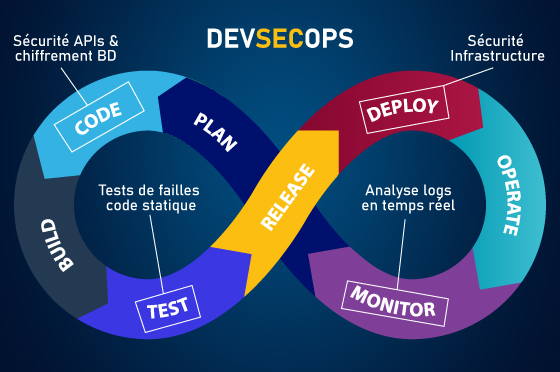
As a result, everyone involved in the software development cycle is responsible for the security of the solution or product to be delivered.
DevSecOps is an approach that emphasizes the need for continuous collaboration with developers, while maintaining an optimal level of security: in addition to unit and functional testing, the developer must add security unit tests.One of the main features of the DevSecOps approach is the automation of application development phases and security automation, which minimizes human intervention just as DevOps does, and industrializes security checks.
In a DevSecOps approach, specific security controls are applied to each phase of the project:
- The architecture definition phase (Plan)
By analyzing the company’s security architecture, it will be possible to determine how applications function and communicate with each other. Following this analysis, companies will be able to set new operational standards and minimum requirements for security testing, as well as deadlines for the resolution of bugs or problems.
- The design phase (Code)
This step is designed to guarantee the security of development and test environments. This requires strict access controls for CI/CD pipelines and additional monitoring, particularly for background scripts. Developers need to be trained in current threats, so that they can take full control of security during the design phase.
- The development phase (Build)
This involves test automation, for which developers will need secure repositories. Static Application Security Testing (SAST) tools should then be incorporated into code construction to detect flaws in the code before it goes into production, and a combination of analysis and scripting tools will ensure that developers only work with released versions. Companies should also establish Interactive Application Security Tests (IAST) here, a method that can be used to identify runtime weaknesses before code is produced.
- The test phase
Tests should be launched as early as possible in the software lifecycle to identify software bugs (before cybercriminals). These test environments must be constantly monitored to ensure their effectiveness. Here, the company can use Dynamic Application Security Testing (DAST) tools to test the application at runtime.
- The pre-deployment phase (Release)
Just before releasing the application, security analysis tools should be used to carry out in-depth penetration testing and vulnerability analysis.
In this phase, it’s the production environments that need to be secured against data leakage.
- The Deploy phase
Once the tests have been completed at runtime, a secure version can be sent to production for final deployment.
The final phase consists of letting the individual test bubbles grow to determine whether the code that worked before deployment also runs during deployment.
DevSecOps presents a real opportunity in terms of cost, as teams are able to track and detect security issues in the early stages of development. This avoids security costs after the product has been released.
What are the benefits of DevSecOps?
This entire chain can be implemented with what is known as the DevOps tool chain.
Improved safety, with :
- Reducing application vulnerabilities,
- Helping implement compliance in the delivery pipeline,
- Maintaining and ensuring compliance,
- The ability to take rapid safety measures in the event of a change,
- Identifying vulnerabilities early in the software lifecycle.
Increasing customer satisfaction,
- Competitive advantage,
- Cost reduction.
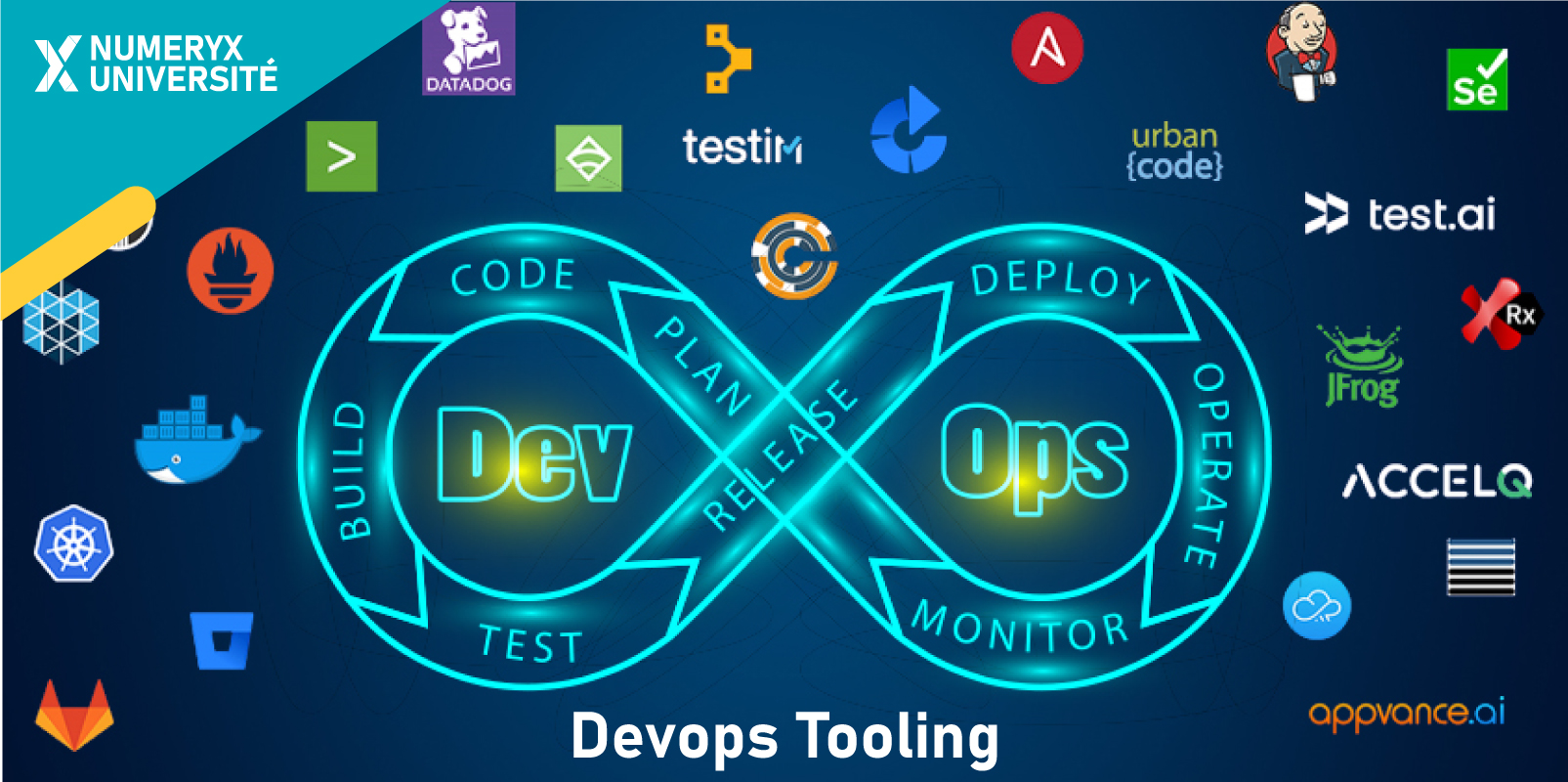
What tools are used in the DevOps chain?
Over time, DevOps is becoming more democratic, and tools for every link in the DevOps chain are multiplying.
So we’ve put together a list of tools ranging from the first link in the chain (Plan), to the last link (Monitor), including DevSecOps security and the Cloud hosting needed to support it all.
Source code management tools (Code)
SVN :
SVN is a centralized version and source code control tool developed by Apache.
It helps developers maintain different versions of the source code and keep a complete history of all modifications.
Git :
Git is a distributed version control system that aims for speed, data integrity and support for distributed, non-linear workflows. In addition to managing source code, it can also be used to track changes to any set of files.
Bitbucket:
Bitbucket is a Web hosting platform developed by Atlassian. Bitbucket also offers an efficient code review system, keeping track of every change in the code. It can be easily integrated with other DevOps tools such as Jenkins and Bamboo.
GitHub:
GitHub is a code hosting platform designed for version control and collaboration. It offers all the distributed version control and source code management (SCM) features of Git, in addition to its own. It offers access control and collaboration features such as bug tracking, feature creation and request, task management, etc. for the project.
Code construction tools (Build)
Maven :
Maven is a powerful project management tool based on POM (project object model), used for building, depending on and documenting projects. It can be used to build and manage any Java-based project. Maven facilitates the day-to-day work of Java developers, helping them to build and run any Java-based project.
Gradle :
Gradle is a code-building automation tool known for its flexibility in software construction. It is used to automate the creation of applications. With Gradle, the build process includes compiling, linking and packaging code.
GitLab (Auto DevOps) :
GitLab is a DevOps platform that enables companies to maximize the overall return on software development by delivering software faster and more efficiently, while strengthening security and compliance.
GitLab CI/CD can automatically build, test, deploy and monitor your applications using Auto-DevOps.
Note that there are separate GitLab CI and GitLab CD services for Continuous Integration and Continuous Deployment respectively.
Continuous integration (CI) tools
Continuous Integration (CI) tools include testing and release tools.
Testing tools
Selenium:
Selenium is the most popular open source testing tool. It supports test automation on various browsers and operating machines. It can be easily integrated with test management tools such as ALM, JIRA and also with other DevOps tools such as Jenkins, Teamcity, Bamboo, etc.
Junit:
JUnit is an open source unit test framework used by developers to write and execute repeatable test cases. It supports various test annotations with which any developer can write a transparent unit test case. It can easily be integrated with other DevOps tools such as Jenkins, GIT, etc.
Release tools
CircleCI :
CircleCI is available as cloud-based and on-premise solutions for continuous integration. It’s quick and easy to get started, and supports lightweight, easy-to-read YAML configurations.
Travis CI:
Travis CI is a distributed, cloud-hosted continuous integration platform used to create and test projects hosted on GitHub and Bitbucket. It is configured by adding a YAML file. It can be tested free of charge for open source projects and for a fee for private projects.
TeamCity :
TeamCity is a server-based continuous integration and build management tool developed by JetBrains. It features a simple, easy-to-use user interface (UI) and provides construction progress, detailed construction information and history information for all configurations and projects.
Bamboo:
Bamboo is one of the popular products developed by Atlassian to support seamless continuous integration. Most of its features are predefined, which means we don’t need to download different plugins like Jenkins. It also supports seamless integration with other Atlassian products such as JIRA and Bitbucket.
Hudson :
Hudson is open-source software written in JAVA and runs in a servlet container like GlassFish and Apache Tomcat. It offers the ability to trigger your automation suite with any change in the corresponding source management system such as GIT, SVN, etc. It also supports all maven and Java-based projects.
Jenkins:
Jenkins is one of the most popular open source DevOps tools for supporting continuous integration and delivery via DevOps. It enables continuous integration and delivery of projects, regardless of the platform on which users are working, using a variety of build and deployment pipelines. Jenkins can be integrated with a variety of test and deployment tools.
Deployment tools
Docker:
Docker is a tool for creating, deploying and running applications using containers. This container allows the developer to package an application with all the components and sub-components it needs, such as libraries and other dependencies, and ship everything as a single package. This works on the concept of the ship and run anywhere.
Kubernetes:
Kubernetes is an open source container orchestration system originally designed by Google and now managed by the Cloud Native Computing Foundation. It is used to automate the deployment, scaling and management of applications. It works with other container tools, including Docker.
Operate configuration tools
Fantoche :
Fantoche is an open-source configuration management tool used to configure, deploy and manage multiple servers. The tool supports the concept of infrastructure as code, and is written in Ruby DSL. It also supports the dynamic ascent and descent of machines according to need.
Chef :
Chef is an open source configuration management tool developed by Opscode using Ruby to manage infrastructure on virtual or physical machines. It also helps manage complex infrastructure on the fly across virtual, physical and cloud machines.
Ansible:
Ansible is an open-source tool for IT configuration management, software delivery, orchestration and application deployment. It’s a simple yet powerful tool for automating simple and complex multi-level IT applications.
SaltStack :
SaltStack is open source software written in python and using the push model to execute commands via the SSH protocol. It supports horizontal and vertical scaling. It supports YAML templates for writing all scripts.
Terraform:
Terraform is an open-source tool for creating, modifying, deploying and managing infrastructure versions securely and efficiently. It is used to manage existing and popular service providers, as well as customized in-house solutions. It helps define the infrastructure in configuration/code and will allow a user to rebuild/modify and track changes to the infrastructure in a simple way.
Continuous delivery tools (CD)
Continuous delivery (CD) tools include monitoring tools (Monitor) and planning tools (Plan).
Monitor tools
Nagios:
Nagios is an open source tool and one of the most popular tools for continuous monitoring. Nagios helps monitor systems, applications, services and business processes in a DevOps culture. It alerts users to problems with the infrastructure, and also alerts them when the problem has been resolved.
Sensu:
Sensu is an open-source monitoring tool written in Ruby that helps monitor servers, services, applications and cloud infrastructure simply and efficiently. It’s easy to scale, so we can easily monitor thousands of servers.
Datadog:
Datadog is an agent-based server measurement tool. It supports integration with various web servers, applications and cloud servers. Its dashboard service provides various graphs on real-time infrastructure monitoring.
WAPITI:
WAPITI is a collection of three open source products – Elasticsearch, Logstash and Kibana – all developed, managed and maintained by Elastic. It enables users to access data from any source, in any format, then search, analyze and visualize that data in real time. Grafana: Grafana is an open-source analytics platform for monitoring all infrastructure, application and hardware device metrics. You can visualize data, create and share a dashboard, configure alerts and collaborate. You can extract data from over 30 sources, including Prometheus, InfluxDB, Elasticsearch, AWS CloudWatch and more.
New Relic:
New Relic is a software analytics product for application performance monitoring (APM) that provides real-time data and trends on web application performance and end-user satisfaction. It supports end-to-end transaction tracing and displays them with a variety of color-coded graphs, charts and reports.
Planning (Plan) and collaboration tools
JIRA:
JIRA is one of Atlassian’s popular project management tools, used for tracking issues, bugs and projects. It allows the user to track project and issue status. It can easily be integrated with other Atlassian products such as Bitbucket, in addition to other DevOps tools like Jenkins.
Slack:
Slack is a freemium, cloud-based collaboration tool that enables team communication and collaboration in one place. This tool can also be used to share documents and other information between team members. It can also be easily integrated with other tools such as GIT, Jenkins, JIRA, etc.
Zoom:
zoom is a web conferencing and instant screen sharing platform. You can ask your team to join you by audio or video. Whatever the size of your team, Zoom can accommodate up to 1000 recipients in an online meeting.
Clarizen:
Clarizen is a collaborative and project management software that facilitates issue tracking, task management and project portfolio management. It is easy to customize and features a user-friendly interactive interface.
Asanas :
Asanas is a mobile and web application designed to help teams organize, track and manage their work effectively and efficiently. It is used to track daily team tasks and support messaging and communication across the organization.
Continuous safety tools (Sec)
Snyk:
Integrate Snyk into the development lifecycle to automatically find and fix open source security vulnerabilities. It supports JS, .Net, PHP, NPM, jQuery, Python, Java, etc. and can be integrated into coding, code management, CI / CI, container and deployment. Snyk has the largest open source vulnerability database.
Netsparker:
Netsparker automatically scans your application for security flaws and provides actionable classified reports so you can take action based on priority. A DevOps security scenario would be to examine the new commit and report the bug directly into the tracking system like Jira or GitHub and reanalyze once fixed by the developer. You see it integrated into every step of the SDLC.
Cloud hosting tools
AWS:
AWS is a web hosting platform created by Amazon that offers flexible, reliable, scalable, easy-to-use and cost-effective solutions. By using this cloud platform, we don’t have to worry about setting up an IT infrastructure, which usually takes a reasonable amount of time to set up.
GCP
Google Cloud is a comprehensive set of public cloud hosting and computing services offered by Google.it supports a wide range of services for computing, storage and application development using Google hardware.
Azure:
Azure is a cloud computing platform designed by Microsoft to create, deploy, test and manage applications and services via a global network of its data centers. The services provided by Microsoft Azure take the form of PaaS (Platform as a service) and IaaS (Infrastructure as a service).
As you probably already know, DevOps and DevSecOps engineers are highly sought-after by companies for all the reasons mentioned in this article.
Numeryx enables you to find your DevOps talent through Technical Assistance recognized by our customers from the world of Industry, Automotive and Aeronautics, Cloud Networks & Infrastructure, in the world of cybersecurity applied to IoT, or even Embedded Systems.
Need DevOps / DevSecOps training?
With Qualiopi-certified Numeryx University, we can offer face-to-face or remote training sessions, depending on your preference and the availability of your resources. Take a look at our catalog of over 140 training courses, or more directly, DevOps/DevSecOps training, by clicking here.
Competitive advantage, Cost reduction. Increasing customer satisfaction, Reducing application vulnerabilities, Helping to implement compliance in the delivery pipeline, Maintaining and ensuring compliance, Being able to take rapid security measures in the event of change, Identifying vulnerabilities early in the software lifecycle.

